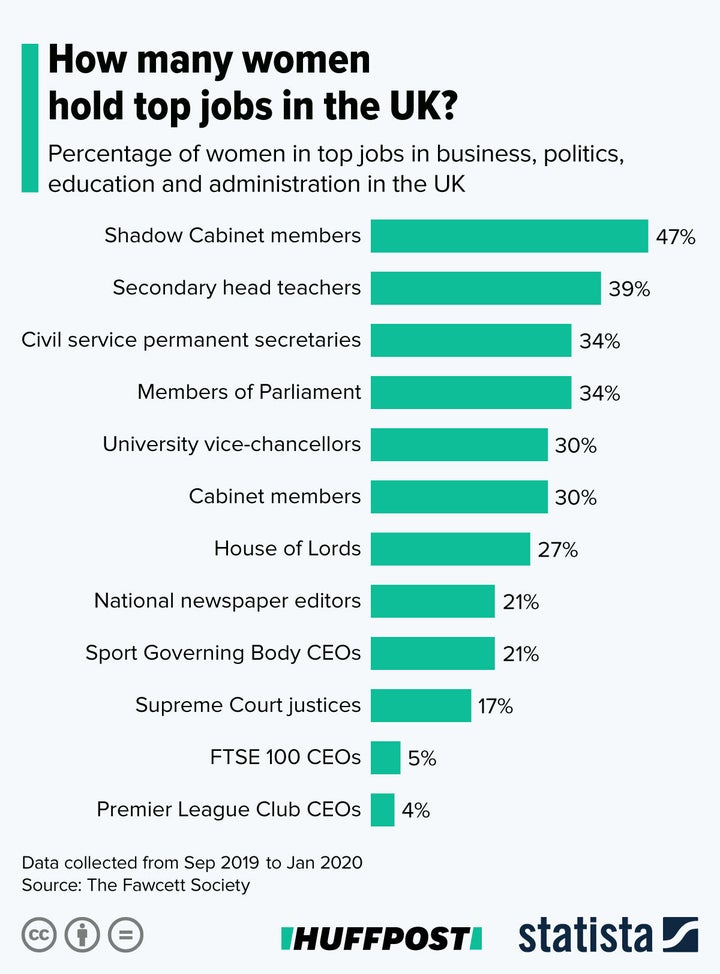The stats are in, and the number of women in top jobs in the UK shows a “dismally slow pace of change”, a leading charity has said.
The Fawcett Society’s 2020 Sex and Power Index charts the extent of male domination of positions of power – and women are missing in “significant numbers” from top jobs in politics, law, civil service, trade unions, charities, professional bodies and sport bodies.
The Index also reveals an alarming lack of women of colour across the top jobs in all sectors.
“We are wasting women’s talent and skills,” said Sam Smethers, CEO of the Fawcett Society. “Despite much lip service about the importance of having women in top jobs, today’s data shows we are still generations away from achieving anything close to equality.”

The data shows:
Law: The Supreme Court has two women justices out of 12 (17%). Since its formation in 2009, there has never been a Supreme Court Judge who is a person of colour.
Business: Women make up just over one in 20 CEOs of FTSE 100 companies. This remains unchanged since the last report in 2018. None of these CEOs are women of colour.
Education: Women make up just 39% of secondary head teachers. This figure has not changed since last reported in 2018 and has risen by 6% since 2005. Women make up 30% of university vice-chancellors – but only 1% of university vice-chancellors are women are colour.
Media: Women make up only 21% of national newspaper editors – with just four women in the top jobs.
Sport: Women make up 21% of national Sport Governing Body CEOs, a drop from 26% in 2018. Only 4% of Premier League Clubs are led by women.
House of Commons: 34% of MPs are women – up only 2% in the recent election. Women of colour now make up 17% of the women MPs, which is in line with the population as a whole.
House of Lords: The percentage of women is at 27%, which is significantly lower than the Commons and up by only 1% since last reported in 2018. Only 2% of all peers are women of colour.
Devolved Parliament / Assemblies: There are no women of colour in the Scottish Parliament, the National Assembly for Wales or the Northern Ireland Assembly.
Cabinet: 30% of the Cabinet are women and 47% of the Shadow Cabinet.
Civil service: Approximately a third of permanent secretaries are women (up from 31% in 2018 to 34% currently). There are no women of colour in these roles.

The Fawcett Society wants the government, political parties, the judiciary and employers to act now to ensure a change in the numbers of women in senior roles.
It’s calling for gender pay gap reporting, reducing the threshold for reporting to companies with 100+ employees from the current threshold of 250 or more.
The charity wants quotas and targets, urging the government to introduce time-limited quotas that organisations must fulfil – these would be put in place to achieve gender parity, and once the gender balance is equal, they would be lifted. Fawcett also argues the government should follow up on its legislation commitment in the Queen’s Speech to make flexible working the default.
And the charity is also calling for more data: government departments, particularly the Office for National Statistics, should prioritise working with relevant sectors to collect and publish intersectional data to accelerate the pace of change, it said.
“If we want change, we have to make it happen,” said Smethers. “That means quotas, targets and policy interventions to remove the barriers to women’s progression.
“Our research also shows the alarming lack of women of colour in the top tiers of many sectors. Fawcett’s new project with the Runnymede Trust on the pay and progression of women of colour will shine a spotlight on the specific challenges and barriers they face in the workplace.”
Infographic supplied by Statista.
